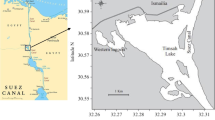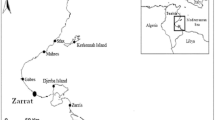Abstract
The annual reproductive cycle of the Antarctic soft-shelled clam, Laternula elliptica, in Marian Cove, King George Island was studied over a 2-year period from February 1998 to January 2000. Annual changes in the gametogenesis were investigated by measuring the percentage of area occupied by oocytes in a follicle [follicle index (FI)] and the oocyte size. In 1998, the monthly mean FI increased significantly from October to November, peaked in December, and decreased rapidly from December to January. In February and March 1999, degenerated eggs were observed in the spent follicles. Degeneration and resorption of residual eggs by phagocytosis occurred mostly in February and March in both 1998 and 1999, although the resorption process was observed year-round. The histology indicated that complete vitellogenic growth of L. ellpitica at Marian Cove takes at least a year and the clams spawn annually during the austral summer. The ripening and subsequent spawning of clams at Marian Cove in 1998 and 1999 coincided with the algal blooming (September–October 1998 and December and January 1999–2000) suggesting that in coastal Antarctica food supply is a crucial factor that governs gonad maturation and subsequent spawning along with the water temperature.








Similar content being viewed by others
References
Ahn I-Y, Cho K-W, Choi K-S, Seo Y-W, Shin J-H (2000) Lipid content and composition of the Antarctic lamellibranch, Laternula elliptica (King & Broderip) (Anomalodesmata: Laternulidae), in King George Island during an austral summer. Polar Biol 23:24–33
Ahn I-Y, Surh J, Park Y-G, Kwon H, Choi K-S, Kang S-H, Choi HJ, Kim K-W, Chung H (2003) Growth and seasonal energetics of the Antarctic bivalve Laternula elliptica (King & Broderip) from King George Island, Antarctica. Mar Ecol Progr Ser 257:99–110
Ansell AD, Harvey R (1997) Protected larval development in the Antarctic bivalve Laternula elliptica (King and Broderip) (Anomalodesmata: Laternulidae). J Moll Stud 63:285–286
Arntz WE, Brey T, Gallardo VA (1994) Antarctic zoobenthos. Oceanogr Mar Biol Ann Rev 32:241–304
Bayne BL (1976) Marine mussels: their ecology and physiology. Cambridge University Press, Cambridge
Bayne BL, Newell RC (1983) Physiological energetics of marine molluscs. In: Saleuddin ASM, Wilbur KM (eds) The mollusca. Academic Press, London, pp 407–515
Berkman PA, Waller TR, Alexander SP (1991) Unprotected larval development in the Antarctic scallop Adamussium colbecki (Mollusca: Bivalvia: Pectinidae). Antarct Sci 3:151–157
Bigatti G, Penchaszadeh PE, Mercuri G (2001) Aspects of the gonadal cycle in the Antarctic bivalve Laternula elliptica. J Shellfish Res 20:283–287
Bosch I, Pearse JS (1988) Seasonal pelagic development and juvenile recruitment of the bivalve Laternula elliptica in McMurdo Sound, Antarctica. Am Zool 28:89A
Chang KI, Jun HK, Park GT, So YS (1990) Oceanographic conditions of Maxwell Bay, King George Island, Antarctica (Austral Summer 1989). Korean J Polar Res 1:27–46
Cheng TC (1981) Bivalves. In: Ratcliffe NA, Rowley AF (eds) Invertebrate blood cells. Academic Press, London, pp 233–300
Clarke A (1987) Temperature, latitude and reproductive effort. Mar Ecol Prog Ser 38:89–99
Clarke A, Prothero-Thomas E, Beaumont JC, Chapman AL, Brey T (2004) Growth in the limpet Nacella concinna from contrasting sites in Antarctica. Polar Biol 28:62–71
de Jong Brink MH, Boer HH, Joosse J (1983) Mollusca. In: Adiyodi KG, Adiyodi RG (eds) Reproductive biology of invertebrates, 1: oogenesis, oviposition and oosorption. Wiley, New York, pp 297–355
Dorange G, Paulet YM, Le Pennec M (1989) Etude cytologique de la partie femelle de la gonade de Pecten maximus recolte en baie de Saint-Brieuc. 2. Ovogenese et lyse ovocytaire. Haliotis 19:299–314
Grant CM, Creese RG (1995) The reproductive cycle of the tuatua-Paphies subtriangulata (Wood, 1828), in New Zealand. J Shellfish Res 14:287–292
Heffernan PB, Walker RL, Carr JL (1989) Gametogenic cycle of three marine bivalves in Wassaw Sound, Georgia: I Mercenaria mercenaria. J Shellfish Res 8:51–60
Hofmann EE, Powell EN, Klinck JM, Wilson EA (1992) Modeling oyster populations III. Critical feeding periods, growth and reproduction. J Shellfish Res 11:399–416
Hooker SH, Creese RG (1995) The reproductive biology of pipi, Paphies australis (Gmelin, 1790) (Bivalvia: Mesodesmatidae). I. Temporal patterns of the reproductive cycle. J Shellfish Res 14:7–15
Howard D, Smith C (1983) Histological techniques for marine bivalve mollusks. NOAA technical memorandum NMFS-F/NEC-25
Humason GL (1972) Staining hematologic elements and related tissues. In: Kennedy D, Park R (eds) Animal tissue techniques, 3rd edn edn. WH Freeman and Company, San Francisco, pp 255–259
Ituarte CF (1997) The role of follicular epithelium in the oosorption process in Eupera platensis Doello Jurado, 1921 (Bivalvia: Sphaeriidae): a light microscopic approach. Veliger 40:47–54
Kang S-H, Kang J-S, Chung K-H, Lee M-Y, Lee B-Y, Chung H, Kim Y, Kim D-Y (1997) Seasonal variation of nearshore Antarctic microalgae and environmental factors in Marian Cove, King George Island, 1996. Korean J Polar Res 8:9–27
Kang C-K, Park M-S, Lee P-Y, Choi W-J, Choi W-C (2000) Seasonal variations in condition, reproductive activity, and biochemical composition of the Pacific oyster, Crassostrea gigas (Thunberg), in suspended culture in two coastal bays of Korea. J Shellfish Res 19:771–778
Kang D-H, Ahn I-Y, Choi K-S (2003) Quantitative assessment of reproductive condition of the Antarctic clam, Laternula elliptica (King & Broderip), using image analysis. Invertebr Reprod Dev 44:71–78
Kennedy VS, Newell RIE, Eble AF (1996) The eastern oyster Crassostrea virginica. Maryland Sea Grant College Publication UM-SG-TS-TS-96-01, pp 734
KORDI (1999) The studies on natural environment and conservation of polar region. Korea Ocean Research & Development Institute (KORDI), ECPP 99001-03
Llodra ER (2002) Fecundity and life-history strategies in marine invertebrates. Adv Mar Biol 43:87–170
Loosanoff VL (1942) Seasonal gonadal changes in the adult oysters, Ostrea virginica, of Long Island Sound. Biol Bull 82:195–206
McCormick-Ray MG (1987) Hemocytes of Mytilus edulis affected by Prudhoe Bay crude oil emulsion. Mar Environ Res 22:107–122
Mackie LA, Ansell AD (1993) Differences in reproductive ecology in natural and transplanted populations of Pecten maximus: evidence for the existence of separate stocks. J Exp Mar Biol Ecol 169:57–75
Mann R (1979) Some biochemical and physiological aspects of growth and gametogenesis in Crassostrea gigas and Ostrea edulis grown at sustained elevated temperatures. J Mar Biol Assoc UK 59:95–110
Park K-I, Choi K-S (2004) Application of enzyme-linked immunosorbent assay for studying of reproduction in the Manila clam Ruditapes philippinarum (Mollusca: Bivalvia): I. Quantifying eggs. Aquaculture 241:667–687
Pearse JS, Bosch I (2002) Photoperiodic regulation of gametogenesis in the Antarctic sea star Odontaster validus Koehler: evidence for a circannual rhythm modulated by light. Invert Repro Dev 41:73–81
Pearse JS, Lockhart SJ (2004) Reproduction in cold water: paradigm changes in the 20th century and a role for cidaroid sea urchins. Deep Sea Res II 51:1533–1549
Pearse JS, McClintock JB, Bosch I (1991) Reproduction of Antarctic benthic marine invertebrates: tempos, modes, and timing. Am Zool 31:65–80
Peck LS, Colman JGA, Murray WA (2000) Growth and tissue mass cycles in the infaunal bivalve Yoldia eightsi at Signy Island, Antarctica. Polar Biol 23:420–428
Poulet YM, Lucas A, Gerard A (1988) Reproduction and larval development in two Pecten maximus (L.) populations from Brittany. J Exp Mar Biol Ecol 119:145–156
Poulin E, Palma AT, Féral J-P (2002) Evolutionary versus ecological success in Antarctic benthic invertebrates. Trends Ecol Evol 17:218–222
Powell DK, Tyler PA, Peck LS (2001) Effect of sperm concentratation and sperm ageing on fertilization success in the Antarctic soft-shelled clam Laternula elliptica and the Antarctic limpet Nacella concinna. Mar Ecol Prog Ser 215:191–200
Rivkin RB (1990) Seasonal patterns of planktonic production in McMurdo Sound, Antarctica. Am Zool 30:5–16
Sastry AN (1979) Pelecypoda (excluding Ostreidae). In: Giese AC, Pearse JS (eds) Reproduction of marine invertebrates. Academic Press, New York, 5:113–265
Saucedo PC, Rodríguez-Jaramillo C, Aldana-Avilés P, Monsalvo-Spencer THV, Monteforte M (2001) Gonadic conditioning of the calafia mother-of-pearl oyster, Pinctada mazatlanica (Hanley, 1856), under two temperature regimes. Aquaculture 195:103–119
Seed R, Brown RA (1977) A comparison of the reproductive cycles of Modiolus modiolus (L.), Cerastoderma (= Cardium) edule (L.), and Mytilus edulis L. in Strangford Lough, Northern Ireland. Oecologia 30:173–188
Sokal RR, Rohlf FJ (1981) Biometry. The principles and practice of statistics in biological research, 2nd edn. W. H. Freeman and Co., San Francisco
Soniat TM, Ray SM (1985) Relationships between possible available food and the composition, condition and reproductive state of oysters from Galveston Bay, Texas. Contrib Mar Sci 28:109–121
Strathmann RR (1990) Why life histories evolve differently in the sea. Am Zool 30:197–207
Strathmann RR (1993) Hypotheses on the origins of marine larvae. A Rev Ecol Syst 24:89–117
Strohmeier T, Duinker A, Lie Q (2000) Seasonal variations in chemical composition of the female gonad and storage organs in Pecten maximus (L.) suggesting that somatic and reproductive growth are separated in time. J Shellfish Res 19:741–747
Thompson RJ (1972) Feeding and metabolism in the mussel Mytilus edulis. L. PhD Thesis, University of Leicester
Thorson G (1950) Reproductive and larval ecology of marine bottom invertebrates. Biol Rev 25:1–45
Urban H-J, Mercuri G (1998) Population dynamics of the bivalve Laternula elliptica from Potter Cove, King George Island, South Shetland Islands. Antartic Sci 10:153–160
Yonge CM (1937) Evolution and adaptation in the digestive system of the Metazoa. Biol Rev 12:87–115
Yonge CM (1946) Digestion of animals by Lamellibranchs. Nature 157:729
Acknowledgments
This research was part of the project Status and changes of polar indicator species and coastal/terrestrial ecosystems (PE08040) and was supported by the Korea Polar Research Institute (KOPRI) of the Korea Ocean Research & Development Institute (KORDI). This study was also supported in part by the Korea Research Foundation (KRF) through The Second Stage of BK21 and KRF-2005-213-F00005 to Kang DH. We are grateful to the divers, Mr. Hyunsoo Kim and Mr. Sungsoo Han, for collecting the clams, and to Dr. Joseph G. Loesch for reviewing an early draft of this paper.
Author information
Authors and Affiliations
Corresponding author
Rights and permissions
About this article
Cite this article
Kang, DH., Ahn, IY. & Choi, KS. The annual reproductive pattern of the Antarctic clam, Laternula elliptica from Marian Cove, King George Island. Polar Biol 32, 517–528 (2009). https://doi.org/10.1007/s00300-008-0544-7
Received:
Revised:
Accepted:
Published:
Issue Date:
DOI: https://doi.org/10.1007/s00300-008-0544-7




